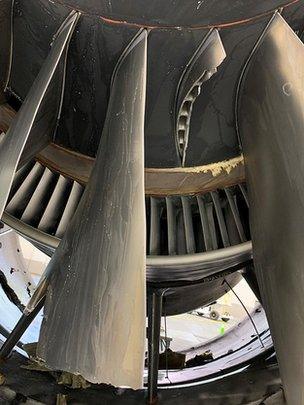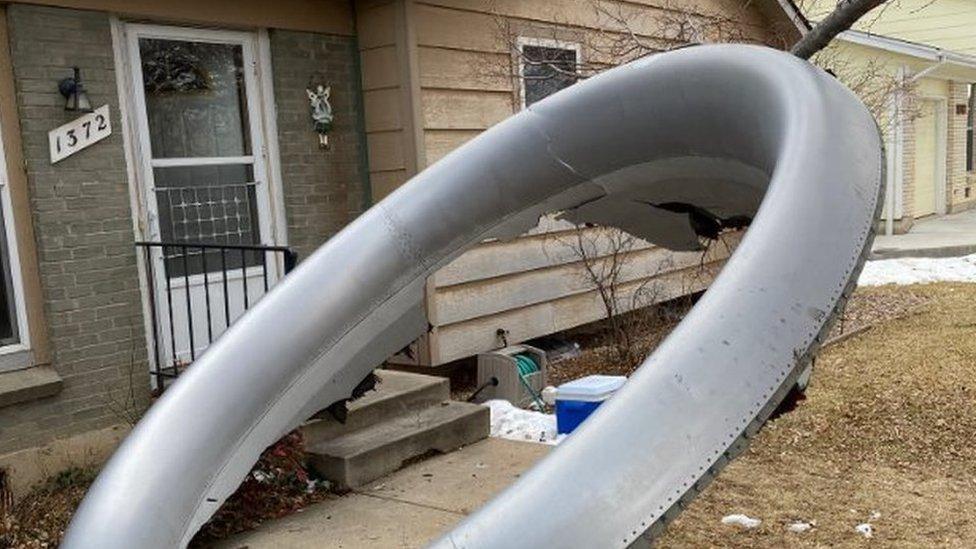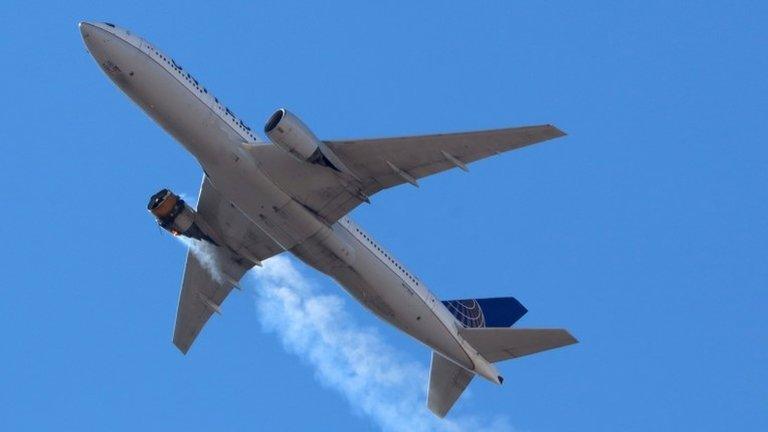Boeing 777: Signs of 'metal fatigue' found on Denver plane engine
- Published
US plane engine fire: "I just knew something was wrong"
One of the fan blades in the plane engine that failed shortly after take-off in Denver showed signs of metal fatigue, investigators say.
The National Transportation Safety Board (NTSB) said the blade would undergo further examinations.
Flight 328 was able to make an emergency landing at Denver airport on Saturday, but parts of the engine fell on homes. No-one was hurt.
Boeing has recommended grounding all its 777 aircraft with the same engines.
It said 128 jets should be suspended until inspections had been carried out. United Airlines, Egyptair, and operators in Japan and South Korea have all said they will not be flying their Boeing-777s.
The NTSB said late on Monday that two fan blades on Flight 328's Pratt & Whitney engine had broken. One of them showed signs of metal fatigue, and investigators believe it broke off and chipped the second blade.
NTSB Chairman Robert Sumwalt said the blades would be flown to a Pratt & Whitney laboratory for further examination by NTSB safety inspectors.
"Our mission is to understand what happened and why it happened so that we can keep this from happening again," he said.
United Flight 328 was carrying 231 passengers bound for Honolulu when it suffered a failure in its right-hand engine. Passengers on board the Denver flight described a "large explosion", external shortly after take-off and the plane began shaking violently and losing altitude.

One fan blade broke off and is believed to have chipped the other

Fortunately the plane was able to return safely to Denver airport but debris from the engine was found scattered over a residential area in nearby Broomfield town. Fragments were found on a football field and what appeared to be the front of an engine-casing landed in the front garden of a home.
On the same day as the Denver incident, an engine failure on a 30-year-old Boeing 747 freighter saw debris fall on a town in the Netherlands. Parts of what appeared to be turbine blades landed on the town of Meerssen, with one blade found embedded in a car roof, according to Reuters. Two people on the ground, one a child, were slightly injured.
The aircraft, which had left Maastricht bound for New York, landed safely in Liege in neighbouring Belgium.

Rare, but dangerous, incident

Aircraft engine failures are rare. Uncontained failures, where debris can erupt from the engine in any direction are mercifully very rare indeed. But an uncontained failure is also much more dangerous.
A modern twin-engine airliner is designed to be able to fly safely for hours using a single engine.
The shrapnel from an uncontained failure, however, can cause serious damage to the rest of the plane, and if it passes through the cabin, it can be lethal. Experts say the failure in the Denver incident appears to have been uncontained, but the damage to the aircraft itself was thankfully minor.
Also worrying is that the incident itself appears to have a number of similarities with another failure that occurred on a United Airlines flight in 2018.
If the cause in this case is found to be the same - and remember, it may not be - that would raise questions about why the response to that incident from the manufacturer and regulators was unable to prevent a repeat.

Saturday's engine failures are another blow for Boeing after its 737 Max aircraft was grounded for 18 months following two aviation accidents that left 346 people dead.

Debris from the engine was found scattered in a residential area
Last December a Japan Airlines 777 flight was forced to return to Naha Airport due to a malfunction in the left engine - the plane is the same age as the 26-year-old United Airlines plane from Saturday's incident.
In 2018, the right engine of a United Airlines plane broke shortly before it landed in Honolulu. Following an investigation, the NTSB said the incident was caused by a full-length fan blade fracture.
- Published21 February 2021

- Published22 January 2021
